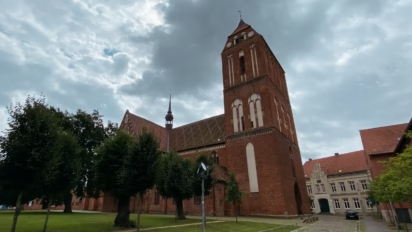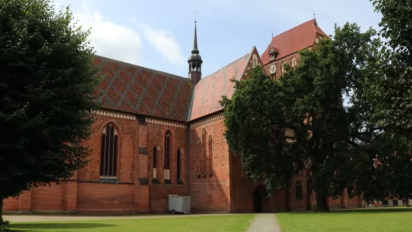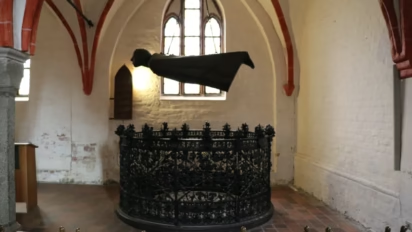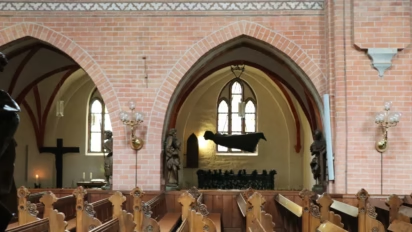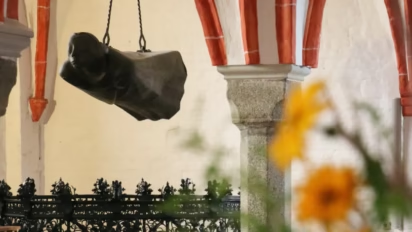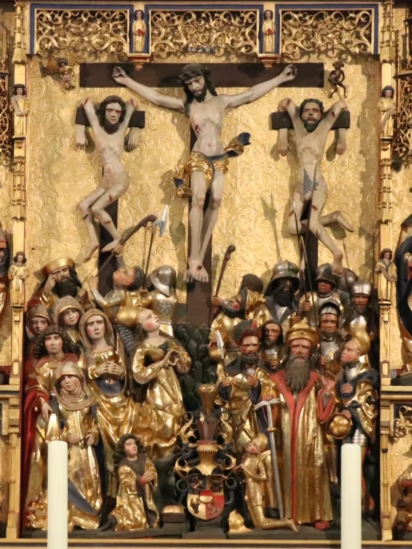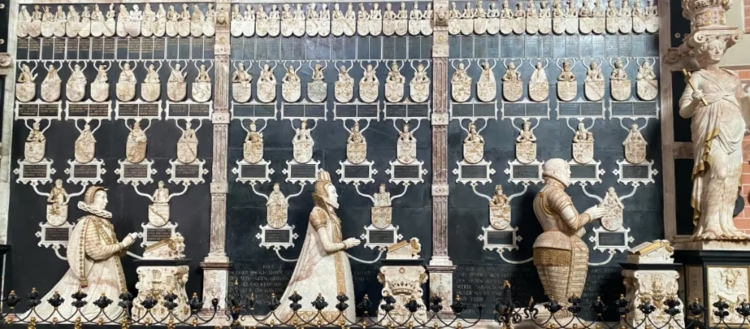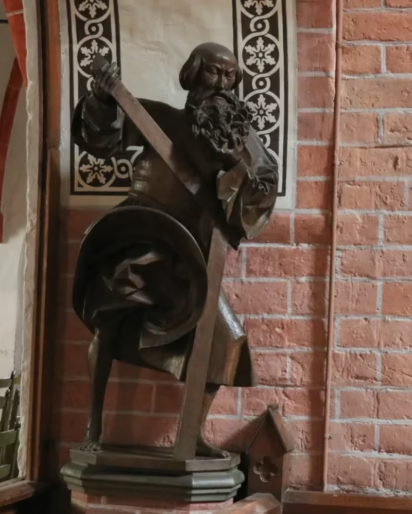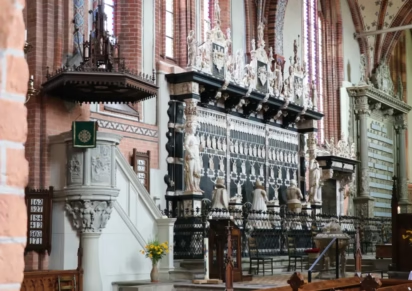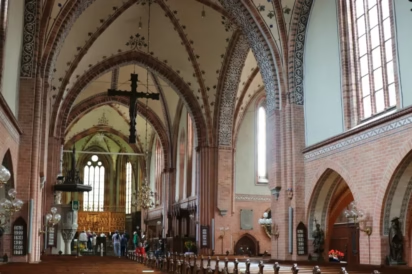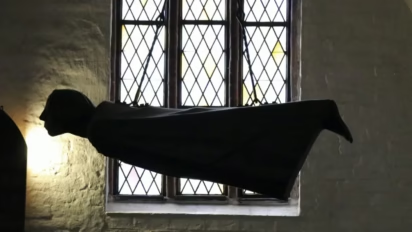Ernst Barlach’s Floating Angel (Der Schwebende) in the Dom zu Güstrow brick gothic church is one of the best-known war memorial sculptures in Germany.

The Güstrower Dom near Rostock in northern Germany is a large mostly 13th-century brick Gothic former collegiate church. The interior is filled with art with the Angel war memorial statue by Ernst Barlach for many modern visitors the main attraction. Many items in the church date from before the Reformation including the large twelve apostles woodcarvings and the winged high alter but the huge Duke Ulrich Monument with Mecklenburg family tree by Philipp Brandin and several further funeral monuments date from after the Reformation when Güstrow was for nearly two centuries a ducal seat. Barlach’s Der Schwebende is often translated as the floating / hovering / flying angel.
Dom zu Güstrow in Mecklenburg-Western Pomerania
The Güstrower Dom is a large brick gothic church in the north German city Güstrow near Rostock in Mecklenburg-Vorpommern. The full name is Dom St. Maria, St. Johannes Evangelista und St. Cäcilia (Minster/Collegiate church of St. Mary, St. John the Evangelist and St. Cecilia) but the Dom in the name refers to its size and close association with the local palace — it was never a cathedral in the sense of a bishop’s seat.
The origins of the church go back to at least 3 June 1226 when Prince Heinrich Borwin II made a generous donation for the foundation of a collegiate church. He died two days later but his father Heinrich Borwin I confirmed the donation (and died himself six months later so the actual building work was started by Nicholas I of Werle).
Most of the brick gothic church was constructed during the 13th century with the church largely completed by 1335 making it the oldest building in Güstrow. The triple nave with slightly offset choir followed the practice of Westphalia of the period. The massive 44-m high western tower, which is wider than the nave, was completed by 1420 and is similar to others in the region, e.g. Havelberg and Tangermünde.
Although a Lutheran church since 1568, the interior is still richly decorated with a vast collection of art and statues — much introduced during the 16th and 17th centuries when the town was the seat of the Güstrow brand of the Mecklenburg ducal family. The church was restored in the 19th century in a neo-Gothic style when the interior and glass were repainted.
Barlach’s Floating Angel in the Güstrower Dom

The most famous artwork in the Güstrower Dom is Der Schwebende — a bronze sculpture of a floating angel originally made in 1927 by Ernst Barlach (1870-1938) as a memorial for the fallen of the First World War. The face of the angel closely resembles that of the famous German sculptor Käthe Kollwitz, who was a close friend of Barlach.
The angel, with eyes closed to the sorrows on earth, floats westwards towards a better world. Barlach wrote that during the war, time stood still for him. It did not fit into anything on earth. It floated and he tried to reflect something of this feeling into the angel that floats through emptiness. (The more prosaic German: „Für mich hat während des Krieges die Zeit stillgestanden. Sie war in nichts anderes Irdisches einfügbar. Sie schwebte. Von diesem Gefühl wollte ich in dieser im Leeren schwebenden Schicksalsgestalt etwas wiedergeben.“)
Former British Museum Director Neil MacGregor described it well in the wonderful to read Germany — Memories of a Nation: “The angel’s lips are closed, soundless. Here, war is internalized, its horror and dread made all the greater by being mute. The angel’s eyes are closed, perhaps unable to contemplate the pain and suffering. … Barlach himself said it was about the attitude we should take to war: Erinnerung und inner Schau, recollection and inner reflection.”
Der Schwebende floats westerly in the eastern bay of the northern aisle of the Güstrower Dom — in the space it was originally produced for. It hovers over a Renaissance wrought metal trellis that originally surrounded the baptismal font.
Two further Barlach artworks are on display nearby: a crucifixion (1918) made for a war graveyard and a terracotta relief of an apostle (1925).
Complex History of Barlach’s Floating Angel
The Floating Angel in the Güstrower Dom is not the original from 1927. That sculpture, together with many ofter of Barlach’s works and memorials, was declared degenerate art (Entartete Kunst) by the Nazis and removed from the church in 1937. It was melted down to recycle the metal as part of the war effort in 1941.
However, shortly before the war, in early 1939, a second bronze copy of the Floating Angel was secretly made from the original model, which was later destroyed in a bombing raid on Berlin. By that time, the new bronze copy was already hidden away near Lüneburg until after the war. This copy has been in the Antoniterkirche in Cologne since 1952.
A third bronze copy (and a new gypsum model) was made from this second angel in 1952 and this is the angel floating in Güstrow since 1953.
A fourth bronze copy was completed in 1987 and is displayed in Schloss Gottorf in Schleswig — this one usually floats over nothing portraying Barlach’s feeling of emptiness possibly the best of all the displays.
The bronzes sometimes travel to major exhibitions but is more likely the gypsum model that is seen away from home.
Der Schwebende has no official translation but is often translated in English as the hovering angel, floating angel, or even flying angel, which is closer to the alternative German name Schwebender Engel. The Floating One is a direct translation of Der Schwebende but really doesn’t work very well, especially as the German schweben is always through the air, there is no possibility of confusing with floating on water. The work is also known as the much easier to translate Güstrower Ehrenmal — Güstrow memorial.
Choir of Güstrow Cathedral

Most of the major artworks in the Dom zu Güstrow are in the beautifully lit Gothic western choir. The large winged altar shines golden from the far distance but the huge Duke Ulrich Monument and other funerary monuments and Renaissance furnishings are also very impressive. (The main burial site for the rulers of Mecklenburg is in the magnificent brick gothic Münster in Bad Doberan near Rostock.)
Main Altar in the Güstrower Dom
The main winged altar in the Dom zu Güstrow glows richly in gold and tends to pull visitors through the vaulted nave straight into the slightly off-center choir. It dates from 1495 and came from the workshop of the Hamburg master carver Hinrik Bornemann. (The more spectacular Borman Altar is in the St Marienkirche in the center of Güstrow).
The altar is usually open on the former high feast day display of the carved figures. A color book allows visitors to see the other options, which include the closed wings with paintings of Mary and Child, John the Evangelist, and saints Cecilia and Cathrine, and partly opened wings with a series of paintings of the passion.
When fully open, the central scene of the altar is the crucifixion of Christ surrounded by two rows of sculptures of the apostle and saints. The two donors of the altarpiece — the Mecklenburg dukes Magnus I and Balthasar — appear twice in the central scene. First, they pray at the bottom with the family shield at the center and then again standing on the far left and right of the gathering around the cross.
As with any major medieval artwork, the messaging is subtle but clear — a small angel hovers over the condemned man on the left (who acknowledged Jesus as Christ) to take his soul to heaven while a small devil is above the man crucified on the right ready to take him straight to hell. The six small figures on the frame of the crucifixion scene are the prophets — their scrolls are empty to show that the death of Christ fulfilled the promises of the Old Testament. On the predella is a painting of Christ surrounded by the traditional four Latin church fathers.
The row of larger figures is mostly the apostles — for unclear reasons Philip is missing — as well as John the Baptist and St Cecilia to Christ’s right and Paul, St Cecilia, and St Sebastian to his left. The smaller seated figures are saints — the information plaque has the full list.
Duke Ulrich Funerary Monument
The huge marble Herzog-Ulrich-Monument (Duke Ulrich Monument) in the choir is a work by Philipp Brandin. Although in effect a grave monument, it was installed while the duke was still alive allowing him to sit in the church across from his near life-size praying sculpture.
Brandin took three years to complete the first parts showing a kneeling Duke Ulrich of Mecklenburg-Güstrow (1527-1603) and behind him his first wife, Elizabeth of Denmark (1524-1586). The epitaph was enlarged in 1599 by Brandin’s pupils Midow and Berninger, to add Ulrich’s second wife, Anna of Pomerania (died 1626).
The caryatids (support pillars) show two female figures with a mirror (left) as a symbol of wisdom and a cross (right) as a symbol of faith. Both qualities considered desirable for a Renaissance ruler but not as vital as his noble birth as is made clear from the giant family tree in the background that confirms the noble origins of the Mecklenburgs.
Twelve Apostles Carved Sculptures in Güstrow
While many visit the Güstrower Dom to see the Barlach Floating Angel, the choir with the magnificent altar and huge monuments tend to draw visitors too fast through the nave. It is thus easy to overlook twelve very remarkable sculptures.
In the arcades separating the central nave from the side naves are twelve almost life-size wooden sculptures of the twelve apostles. These were carved around 1530 by Claus Berg, a master from Lübeck. Berg carved his apostles as defenders of the faith against the heresy of the Lutheran Reformation. These sculptures use the typical apostolic symbols almost as weapons to fight for the real faith. Even Andreas seems ready to attack with rather than die on his cross.
These Apostles of the North were long the most revered artworks in the church. They are particularly good examples of late Gothic woodcarving although the master of the genre was Tilman Riemenschneider who worked further south in Franconia.
Further Art in the Dom zu Güstrow
The triumphal crucifix hanging in the crossing is from the mid-14th century but many of the other artworks in the collegiate church date from the period of Duke Ulrich including:
The sandstone chancel is by Johann Parr — brother of the castle builder — and shows on the three relics the twelve-year-old Jesus in the temple, the baptism of Christ, and the first sermon by Peter.
The Renaissance sandstone and alabaster baptismal font (1592) is by students of Brandins. The pillars carrying the bowl are statues of Hermes — a confirmation of how easily the Renaissance blended Christian beliefs and ancient Greek mythology.
The epitaph and tomb for Baldwin II, who financed the church, were also only added to the church during the late 16th century.
Visitor Information for the Güstrower Dom
The opening hours of the Dom zu Güstrow move around a bit making it sensible to enquire exact details before traveling.
The church is usually open Tuesday to Sunday from 10:00 to noon and from 14:00 to 16:00. Sundays only after the morning service. From mid-November to end-March, the opening hours are usually only from 11:00 to noon and 14:00 to 15:00.
During summer months, mostly June to September, the church is sometimes open daily from 10:00 to 17:00.
Admission is free — small fee for photography.
Information inside the church is mostly in German only.
Visiting Güstrow in Mecklenburg-Vorpommern
Güstrow is a small town of around 30,000 inhabitants around 30 km inland of Rostock in the north German state Mecklenburg-Vorpommern. It was the residential seat of the Dukes of Mecklenburg-Güstrow during the 16th and 17th century but since the line died out in 1695 Güstrow had a quiet provincial existence.
The top sights in Güstrow include the Dom with Barlach’s Floating Angel and huge Ducal epitaphs, the St Marienkirche with its rich interior (Borman Altar), and the Renaissance Schloss (the modern interior with a major paintings gallery is being renovated but the exterior and park are open for free).
Güstrow refers to itself as Barlachstadt as the German sculptor Ernst Barlach lived here from 1910 until his death in 1938. The Gertrudenkapelle to the west of the town center has works from his Güstrow period while the larger Atelierhaus a few kilometers to the south of Güstrow has a larger display of his work in his former house, studio, and modern exhibition center.
Güstrow is around half an hour’s drive to the south of Rostock or two hours (200 km) to the north of Berlin. The town center is very walkable — park near the Schloss and stroll to all the sights.
Trains to Güstrow take around 30 minutes from Rostock on the at least hourly S-Bahn train or 20 minutes on the infrequent Regional Express trains. Train travel from Berlin takes two to three hours (direct a few times per day but often requires transfers). The train station is around a km to the north of the town center.
Güstrow is also a pleasant town to spend the night in with hotels often far cheaper than in nearby Rostock — see Tripadvisor recommendations. Drivers may prefer the very pleasant countryside options in the forests and near lakes.
More photos of Güstrow on Flickr.
